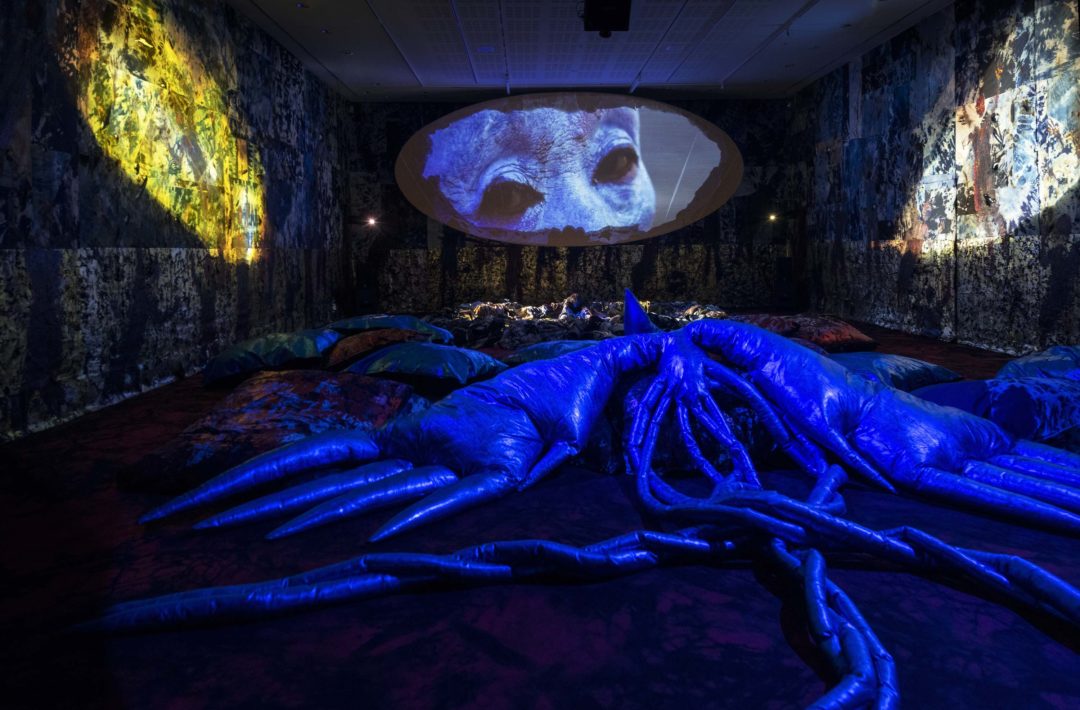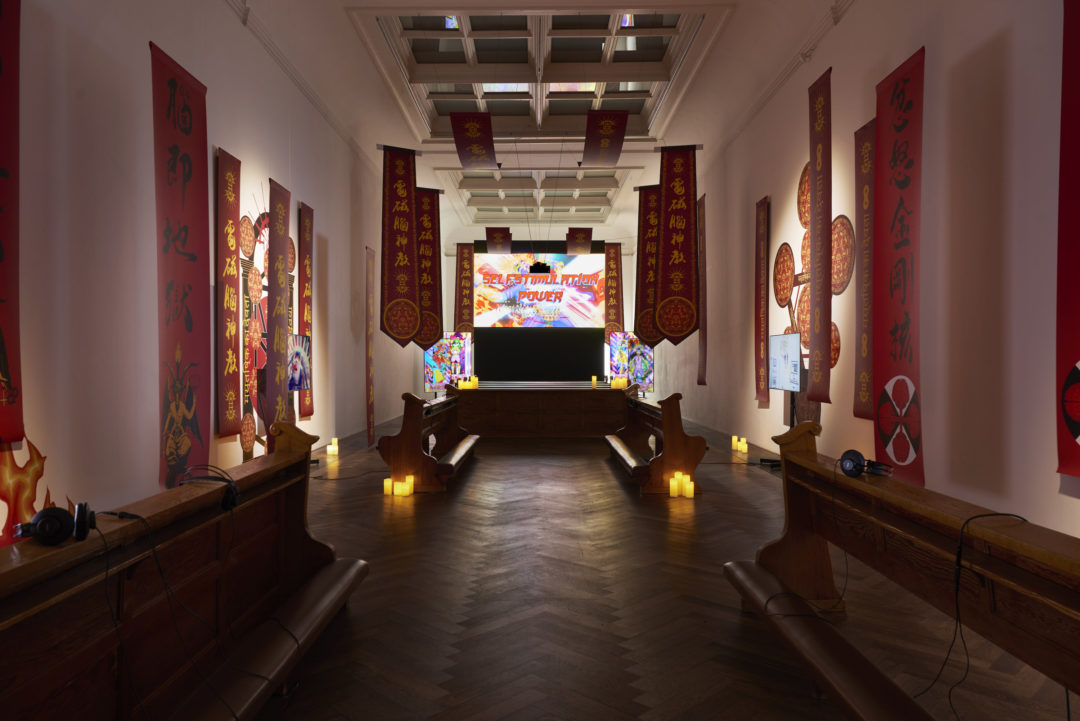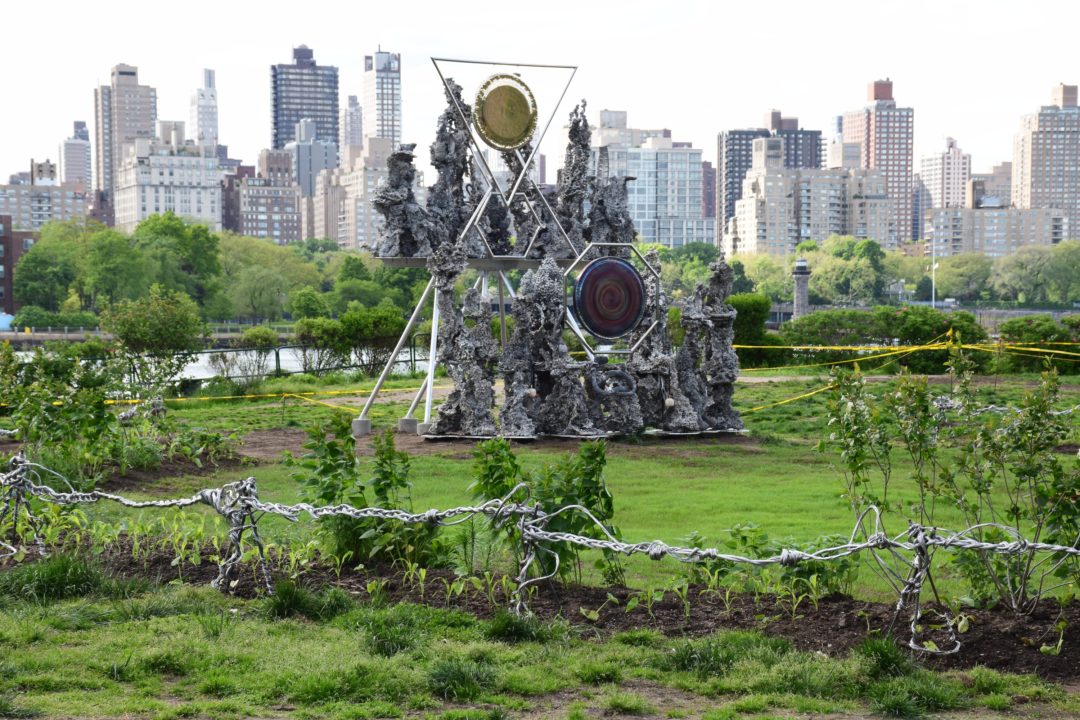The techno-vernacular movement (part.2)

Shedding new light on the insights of vernacular practices in the era of new digital technologies. (Part II)
Part one of “The Techno-Vernacular Movement” outlined the emergence of an ensemble of artistic practices which appropriate technological developments in order to highlight knowledge and spiritualities which have been erased by western colonial and economic history. Part two takes this exploration further and sketches out the potential agency techno-vernacular artists represent.
From Indigenous Immanence Toward Spirituality as Technology (continued)
“You told me this was from a past life when I was a tree living in the forest / it was a time of rapid climate change / and the trees had to work together to create their own micro-climate / because without biodiversity / the ground would lack nutrients / and the forest would die / (the garden of the gods) it’s a monoculture farm / with trees enslaved in the agricultural system / with their roots isolated from the forest network / they cannot talk to the rest of the forest / possessed only from the orders from above”
In this excerpt from Songs for Dying (2021), Korakrit Arunanondchai (1986, Bangkok) elicits a meditation on the cycle of creation and un-creation common to all things. Songs for Dying is a video installation which entwines the end of the artist’s grandfather’s life with videos of pro-democracy protests in Bangkok in 2020 and also images filmed on the Korean island Jeju, a place where a massacre was perpetrated against the local population by the Korean military junta in 1948. In this work, the process of separation of body and spirit is accompanied by singing and Buddhist rituals and revolves around the cycles of life and emergence in the beyond. In Bangkok, the bodies and individuals in the crowd attest to the ideological scission between them and the Thai monarchy, in the hopes of a new regime. On the island of Jeju, vernacular funereal rituals honour the collective phantoms of ancestors whose lives were lost in the massacre. The rites practiced by the artist form a link between the living and the dead; they are both a collective healing process and a form of resistance against the erasure of history.At the heart of this triple narrative is a sea turtle as mytheme, a timeless myth which reappears in contemporary popular culture—in this instance, as a cosmic figure descending from a dragon. Arunanondchai’s video installations present the viewer with the experience of a flood of images and sounds in an immersive environment while enveloped in a bean bag chair covered in a faded jean material, all of which create an appropriate emotional space for meditative contemplation.

In the work of LuYang (1984, Shanghai), pop culture, Eastern religions and their philosophies fuse with new technologies to mutate incessantly in cyberspace—the new extension of our cosmos—while faced with the catacylsmic exploitation of resources. Since childhood, LuYang has sustained an interest in the Buddhist beliefs of their grandmother. They are passionate about Japanese otaku subcultures (video games, anime), science-fiction, techno-culture and post-humanism. Their work DOKU (2020-) originated with an avatar, a digital reincarnation of their own body, which operates in the context of performances, installations and video games, mandalas and light boxes. The work evolves with each new collaboration with musicians and dancers to become the receptacle for a new appearance —DOKU exists in six versions: Human, Heaven, Asura, Animal, Hungry Ghost and Hell. In order to give birth to them, LuYang collaborated with four Bali dancers and a Japanese pop dancer. Their movements, facial and eye expressions were recorded using cutting-edge technology, then transmitted to each of the six DOKU avatars. Each DOKU has itsown dance, soundtrack, costume and universeand is the incarnation of the one of the six kingdoms of rebirth of the saṃsāra—the karmic wheel which symbolises the eternal cycle of life, death and reincarnation which is found in Hinduism and Buddhism. The avatars are what allow LuYang to dissolve the limits of the physical body, as well as of identity, in order to reach a non-binary, asexual state which is in perpetual flux. In the installations, which are somewhere between temples and arcade games, new technologies transform humans into an augmented, collective, ubiquitous and nearly divine entity.

Healing the Matrix
In its most radical form, the techno-vernacular holds the potential for a general movement toward activism and the development of agency with regard to dominant constructs. Many techno-vernacular artists find common ground through the notion of healing; a domain which has previously been claimed by western sciences. Medical science has nonetheless had its share of systemic breakdowns. In 2019, it was discovered that the artificial intelligence (AI) used by hospitals was only processing requests for care from people of colour when they had reached a much more serious stage of illness when compared with white patients when they received care. This discrimination is present in many AI systems due to the fact that the data sets used by the algorithms are themselves riddled with bias and racial discrimination. This bias is more widely present in digital tools. The early works of Tabita Rezaire (1989, Paris), like the video Afro Cyber Resistance (2014), calls out the World Wide Web as a West Wide Web, a form of western technological and patriarchal coloniality which erases the so-called Global South as well as minorities, creating cyberslaves. Exorcising and healing technology therefore becomes a priority, requiring the rehabilitation of forms of knowledge which have been erased.
Patricia Domínguez (1984, Santiago de Chile) explores healing practices which emerge from points of socio-historical convergence between pre and postcolonial worlds, particularly between syncretism and mestiza practices from South America. In the installation Matrix Vegetal (2021-2022) (Plant Matrix), five display-altars which honour four sacred plants feature archival documents, artefacts and seeds from the Wellcome Collection and the Kew Gardens, an inheritance of a colonial past which has been contextualised by the artist. Domínguez draws attention to the way that western natural sciences have—in spite of all of their contributions—homogenised our relationship to plants and are often based on biopirating: the pillaging of natural resources and native knowledge, especially with the patenting of living organisms. One of the totems recognises the contributions of Manuel Mamani, the 19th century doctor and Aymara cascarillero who was killed after having given cinchona seedsto westerners. The holograms which hang above the installation alternate between showing animated indigenous plants and the allopathic medications which are made from them, pre-Colombian statuary—an echo of the origins of this phytotherapeutic knowledge—and the artist’s irritated green eye in tears. Another altar is dedicated to ayahuasca—a preparation of pre-Colombian liane which produces psychedelic effects which were traditionally used in shamanic ceremonies—lauded here as a method of disconnecting from the digital matrix and reconnecting with the plant matrix. The watercolours made by the artist as well as the central totem, celebrate shamanic, decolonial and activist vision. This vision also materialises in the collaborative platform Studio Vegetalista which was created by the artist in 2015 and calls for the redefinition of the relationship between humans and plant life through experimental classes, spiritual connections, ethno-botanical illustrations and collaboratively-produced publications.
Collective practices are an integral part of the work of Guadalupe Maravilla (1976, San Salvador) as well. The Salvadorian-American artist and healer combines the pre-colonial ascendance of central America with a personal mythology influenced by his experiences migrating to the United States. His interactive installations from the series “Disease Throwers”(2019-) are machines for healing collective traumas related to immigration and colonialism. His Disease Throwers (#13, #14) Installation (2021) is located in a garden of medicinal plants designed by the artist, taking the form of two totems of Mayan influence. Reminiscent of coral reefs, they are made of steel, fruits and vegetables formed out of recycled aluminium, decorative plates and other pieces collected in central America, from toys to sacred objects. Two gongs, tuned to the frequencies of different planetary systems, are activated with conches, tuning forks and triangles. During activations of Disease Throwers, he officiates with others in the role of a sound healer, creating a therapeutic bath of vibrations for the public, particularly for communities in a state of physical or emotional distress, like people undergoing cancer treatment, undocumented migrants from Latin America and their families. In 2012, Guadalupe Maravilla was exposed to a sound bath for the first time in order to counter the dehydrating effects of radiation therapy during cancer treatment. For the artist, the illness—which he sees as being directly connected to his unaccompanied migratory journey at the age of eight— allowed him to make connections with the traditions of curanderos, sound therapy and Tibetan chants. He sees his work as inherently political, “I have a vision already of what I want for the future. And that is to actually create my own temples, which will be community spaces, full of sculptures and murals. I want them to be warehouses for collecting and distributing food if there’s another crisis. I want them to be spaces for marginalized communities that can go and heal, but I also want the spaces to be free of the government, free of the church and free of institutions.”

Communities, Hybridities, Agencies
We, CRO, call upon the sensibilities and knowledge of the living who came before us, in order to reconnect with our communities and our environment. While industrial revolutions may have distanced us from these things, exchanges with our elders, a fascination for living things and the usage of new technologies will all facilitate the birth of fecund alternatives. The rediscovery of fermentation processes with vinegar, natural winemaking, medicinal plant practices; all are ways of getting in touch with our vernacular specificities in order to become familiar with living technologies. Our families have only partially transmitted these techniques to us. Modern western society convinced them that they were obsolete and that the rural exodus was a one-way ticket toward progress. Faced as we are with ecological catastrophe, overconsumption, individualism, dominance and the homogenisation of culture, the techno-vernacular movement holds the potential for the creation of transnational, trans-generational and trans-species alliances. In this collective process of mutation toward a multicellular state, new and ancestral technologies are being hybridised and updated in order to become inclusive; they re-connect us to our environment and provide healing from a non-viable capitalism. Producing artworks amounts to producing spaces for empathy, for debate and for learning, like Amakaba, Studio Vegetalista or Pickle Bar. We feel that the techno-vernacular is a way of invoking an augmented form of ancestry, reactivating sprititualities, techniques, recipes and languages which have been refined from one generation to the next through a hybridisation of the local and the global, yesterday and tomorrow, in order to take action for today.
1 Any mention of the massacre was considered illegal and would be censored up until 2003.
2 Shorthand for « Dokusho Dokushi », a Japanese Buddhist sutra which means “we are born alone, we must die alone”.
3 The Balinese dancers include : a dancer from kebyar duduk, Wayan Purwanto, another from legong, Ni Kadek Sudarmanti a dancer from rangda, Made Sukadana ; and a warrior dancer, Dewa Putu Selamat Raharja.
4 kEnkEn.
5 Certains DOKU skins were designed by tattoo artist Taku Oshima.
6 Crystal Grant, “Algorithms Are Making Decisions About Health Care, Which May Only Worsen Medical Racism”, ACLU, octobre 2022.
7 Designed by CMB, studio architects based in Madrid.
8 A museum which specialises in medical science whose aquisitions, between 1890 et 1936, were guided by a European model of cultural hierarchies.
9 A specialist who forages for seeds and bark. Seeds collected by Mamani are featured in this totem.
10 Trees, whose high quinine content are used for the treatment of malaria, and which were then imported and grown in India and Indonésie by the British and the Dutch.
11 Animations by Alvaro Muñoz.
12 Borrowed from the museo de América, Madrid, with whom the artist collaborated; these statues are representations of shamans, hierbateras, or medicinal plant doctors.
13 Domínguez received training in illustration at the New York Botanical Gardens (2010-2011).
14 Dans le cadre de l’exposition « Planeta Abuelx », New York, Socrates Sculpture Park, 15 mai – 6 septembre 2021.
15 Guérisseurs dotés de pouvoirs surnaturels.
16 Guadalupe Maravilla (interviewed by Aruna D’Souza), « Guadalupe Maravilla is Making Space for Healing », in Frieze, 4 mai 2022.
______________________________________________________________________________
Head image : Patricia Domínguez, Matrix Vegetal, 2021, totems, watercolors, herbal archival material, 3D animation on holographic projectors and plant offerings. Totems designed in collaboration with Bate.work. Installation view of the exhibition “Rooted Beings”, Wellcome Collection, London, United Kingdom, 24 March – 29 August, 2022. Courtesy of the Wellcome Collection. Photo: Steven Pocock.
- From the issue: 104
- Share: ,
- By the same author: The techno-vernacular movement (pt.1),
Related articles
Paris noir
by Salomé Schlappi
Some white on the map
by Guillaume Gesvret
Toucher l’insensé
by Juliette Belleret

